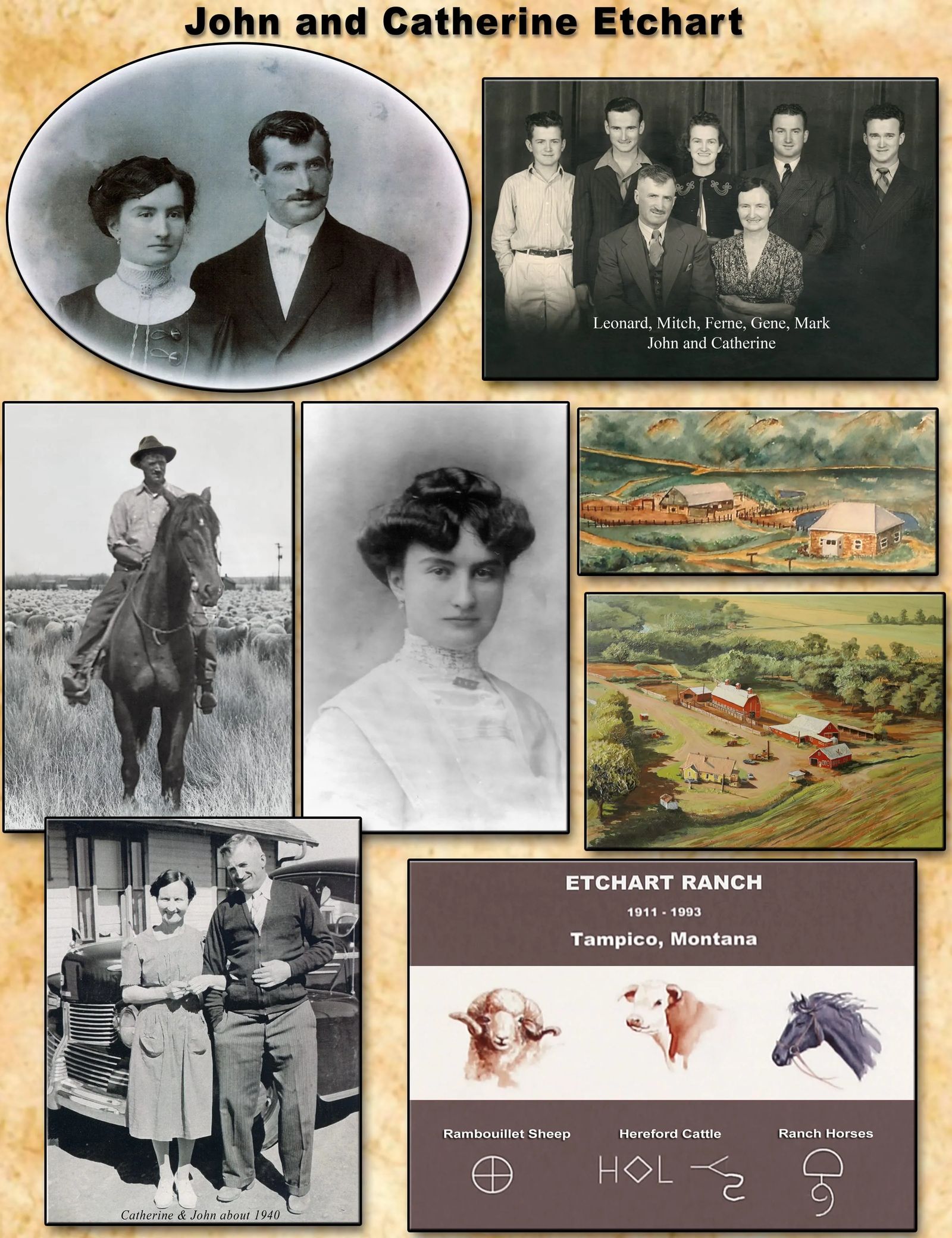
MONTANA COWBOY HALL OF FAME LEGACY INDUCTION
JOHN & CATHERINE (URQUILUX) ETCHART (1882-1943) (1888-1978)
DISTRICT 1 - YEAR 2023
John Etchart was born in 1882 in the village of Aldudes, in the Basque country, located on the border of France and Spain. At age 18 he immigrated to the United States. He worked as a sheepherder in the foothills of Santa Monica, California for a year to reimburse his employer for the cost of his voyage to America.
John became a U.S. citizen and with his brother Michel, moved to Nevada for nine years where they operated a sheep ranch in partnership with a banker based out of the town of Elko. They managed the business during the open range days. This allowed their sheep to graze while trailing them in the summer from the Bruneau Mountains of Idaho to Arizona, where they grazed in the winter, and back to Idaho. In 1910 while John was breaking a horse, his leg was severely fractured causing considerable medical costs that the banker refused to share with the brothers. They soon cashed out and dissolved the partnership, changing the course of John’s life.
John traveled by train and ocean vessel back to Aldudes that same year, and while contemplating his ranching future, he met Catherine Urquilux. They began a two-year courtship in 1911, during which time John returned to the U.S. to consider the purchase of open grazing land in Northeast Montana, recommended by a local Basque. John arrived in Saco by train, rented a horse for a two-day ride 50 miles to the South country in Valley County. John bought the ranch on the spot and later purchased two bands of sheep from Deer Lodge, Montana. Later in life he told his sons that these were the best grasslands he had ever seen.
In 1912 John revisited Aldudes where he and Catherine were married. They sailed to America as newlyweds, arriving in Valley County where they would build their ranch together. They ran Rambouillet sheep branded with their Circle Cross brand. Ewes were paired with purebred rams, having clean open faces not prone to becoming wool blind. John and Catherine increased their herds requiring additional sheepherders, camp tenders, horses, and cooks. The Etcharts employed various local residents and newly immigrated Basques.
John, along with two German stonemasons, built their house and barn in 1914. The Stone House became a local landmark. Around this time the Etcharts entered into the cattle business buying Hereford range cattle; branding them with the Lazy Y Hanging Reverse S. John and Catherine dealt with constant challenges: winters of deep snow, summers of drought, finding sustainable grass, and the constant toll of predators. Some winters they lost half of their entire sheep herd.
In the early 1920s, John and Catherine expanded their holdings into north Valley County along the Porcupine Creek, adding more grazing lands for both sheep and cattle. Sheep were wintered south then trailed 70 miles to the North Ranch for lambing, shearing, and summering. Cow calving and branding occurred both on the North and the South ranches. The couple increased their holdings with the purchase of the Tom Dignan irrigated farm near Tampico, 12 miles northwest of Glasgow, Montana. Around 1922 the Etcharts and their children, Ferne, Gene and Mitch, moved to the newly acquired property. A few years later two more sons, Mark and Leonard, were born to land capable of producing large amounts of winter feed: mainly hay and sugar beets. Corn for silage replaced the beets in the 1940s. As the ranch grew, the public domain lands were a free-for-all fight for grazing rights. The Taylor Grazing Act of 1934 divided public domain grasslands into districts, which had to be held under permit by qualified ranchers. John was the chairman of the Montana State Grass Conservation, which helped implement the act.
Catherine, an early riser, worked alongside John on the day-to-day operations, keeping financial records and making payroll. With her assistant cook, she prepared breakfast for the ranch hands by 6:30 AM each day. Cleaning chores and food preparation for the noon and evening meals began shortly thereafter. Catherine, who was enterprising, raised hogs, Holstein dairy cows, chickens, turkeys and an abundant vegetable garden. She canned delicious meat and fruits and to everyone’s delight made French custard and chokecherry wine. Catherine was frugal and ingenious at financial savings but also generous donating time and money to St. Raphael's Catholic Church and other charities. John and Catherine together instilled Christian values along with a disciplined work ethic in their children.
In the late 1920s and 1930s improvements and mechanization emerged on the ranch. The Etcharts improved the land by creating reservoirs, benefiting both domestic animals and wildlife. Percheron horses pulled the hay machines, mowers, rakes, and stackers until the early 1930s. John implemented the beaver slide hay stacker design he had seen in Deer Lodge. Horsepower was replaced with gasoline engines in the 30s and 40s. By this time, John, who was transitioning from sheep to strictly cattle, purchased purebred Herefords he branded with an H Diamond L.
John was the director of the Montana Production Credit Association, Montana director of the National Wool Marketing Corporation, director and Vice President of the Montana Wool Growers Association, and a member in good standing with the Montana Stock Growers.
John passed away unexpectedly in 1943. Gene, Mitch, Mark, and Leonard took over the day-to-day operations with Catherine’s guidance. She continued the recordkeeping and chores for the Tampico ranch until her death in 1978. John and Catherine’s legacy that began in a small village in the Basque country of Europe continues to live on through their grandchildren.
References:
The John and Catherine Etchart Family Album, by Gene Etchart
History Committee Valley County 1991 “Footprints in the Valley” – a History of Valley County, Montana Volumes 1, 2, and 3

